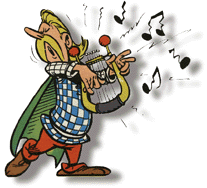 |
Musical Instruments of Antiquity as Illustrated in
|  |
Part 4: Natural Wind Instruments (Horns and Alphorns)
Animal Horns
| Many ancient cultures used animal horns as primitive musical instrumets. Rams horns and the horns of some cattle are hollow conical bore wind instruments, and are played much the same way that a modern bugle is played. The ancient Israelites in the Bible used a shofar made from ram's horns. The shofar was sounded to announce important days in the religious calendar, for processions, as musical accompaniment, and as an announcement of war. The Bible even mentions two distinct types of sounds played on the shofar. The tekiah was a plain deep bass sound with with an abrupt ending, and the teruah was a treble trill, usually played between two tekiahs. |
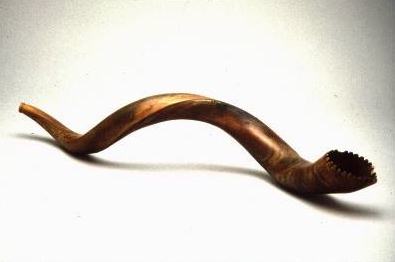
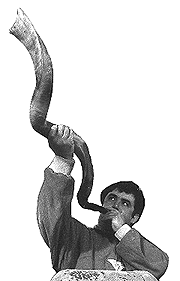
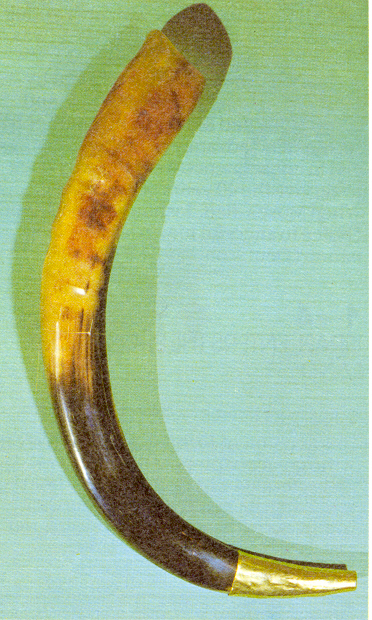
|
|
In Asterix the Goths Goscinny and Uderzo document the use of the cowhorn by the ancient Germans (known then as Goths, OstraGoths, Visigoths) for announcing mealtimes and other military announcements in tribal military camps. Notice the different playing styles: "BOOOOOO" versus "BOOOAAA, BAAAOOO" used to convey different meanings.
|
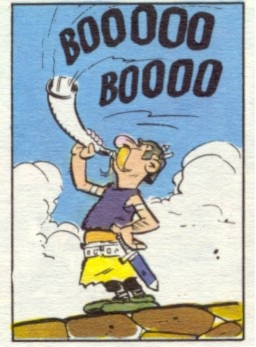
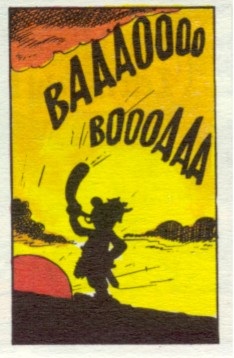
|
|
In Asterix and Cleopatra Goscinny and Uderzo document the use of the cowhorn by the ancient Egyptians. The Egyptians apprarently used the lip embouchure to produce a change in notes, as indicated by the "BOUHOUHOUHOU" or "BOUOUOUOU" sound notation of a slow trill.
|
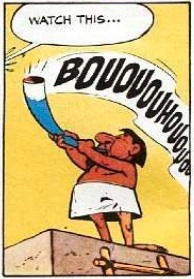
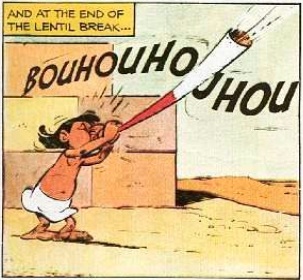
|
|
In Asterix in Britain we see documented use of the horn by a druidical referee to announce the kickoff of the tribal crown rugby match between Camulodunum and Durovernum.
Once again Goscinny and Uderzo are able to illustrate differences in performance styles between different cultures with similar musical instruments. In Ancient Roman Britain, the animal horn was apparently played with a "PARP" tonal quality rather than the "BOOOOOO, BOOAAA, BAAAOOO" used by the Germanic Goths.
But, then again, perhaps the "PARP" sound was a specific sound used for athletic events. The Druid referee at the rugby match in Asterix in Britain plays a "PARP" on the horn, and - as indicated in Asterix and the Big Fight - a Roman buccina player produces a similar "PAAAARP" sound to initiate a boxing match. |
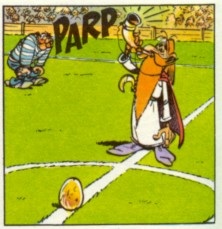
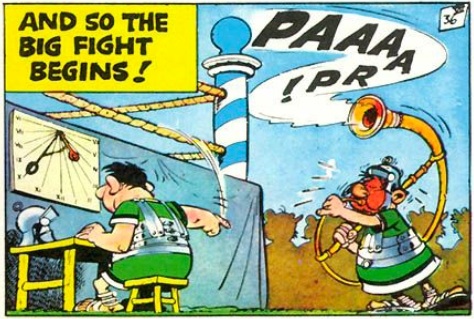
|
Alphorn
|
The alphorn is a natural wooden horn with a conical bore and having a cup-shaped mouthpiece It is used by mountain dwellers in Switzerland and elsewhere. Similar wooden horns were used in most mountainous regions of Europe, from Sweden to the Romanian Carpathians. The alphorn, as we currently know it, is not well documented in Switzerland until the 1500's, so it might seem that the appearance of the instrument in Asterix is a bit early. However, the cave drawings dating back 100,000 years show Aboriginies blowing the Australian Didgeridoo, which is similar to teh alphorn. In addition, there is a 2nd century Roman mosaic showing a shepherd blowing an instrument similar to an alphorn.
(From Wikipedia): The alphorn is carved from solid softwood, generally spruce but sometimes pine. In former times the alphorn maker would find a tree bent at the base in the shape of an alphorn, but modern makers piece the wood together at the base. A cup-shaped mouthpiece carved out of a block of hard wood is added and the instrument is complete. The alphorn has no lateral openings and therefore gives the pure natural harmonic series of the open pipe. The harmonics are the more readily obtained by reason of the small diameter of the bore in relation to the length. An alphorn made at Rigi-Kulm, Schwyz, and now in the Victoria and Albert Museum, measures 8 ft. in length and has a straight tube. |
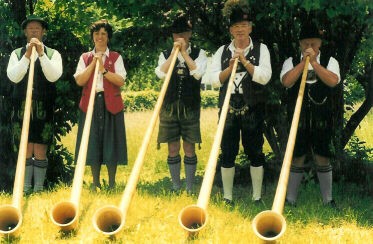 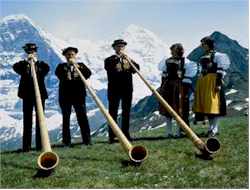
|
When Asterix and Obelix visit Switzerland (Asterix in Switzerland) they encounter the harmonious sounds of yodelling to the accompaniment of the Swiss Alphorn. The alphorn in this figure appears to made of metal rather than of wood. 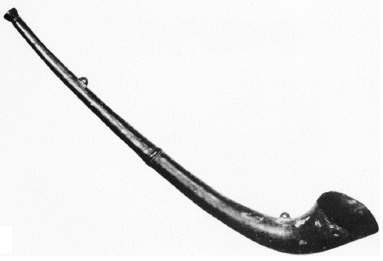 Perhaps this is an ancestor to the modern alphorn, similar to the metal celtic bugle found in the Berlin-Charlottenburg collection in the Staatliche Museen.[1] Perhaps this is an ancestor to the modern alphorn, similar to the metal celtic bugle found in the Berlin-Charlottenburg collection in the Staatliche Museen.[1]
|

|
| We also see - as was the case with the Carnyx - that the alphorn is not just a musical instrument, but also comes in very handy when one is trying to fend off attacking Roman legionaries. |
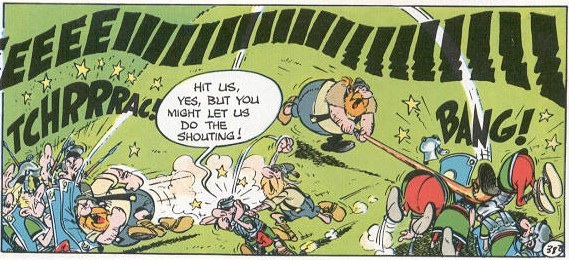
|
 Music in Asterix TOC
Music in Asterix TOC